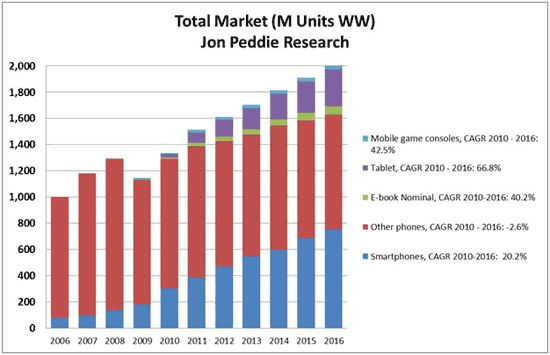TIBURON, CA-October 11, 2011 Today, Jon Peddie Research (JPR), the industry’s research and consulting firm for graphics and multimedia, announced its new report on mobile devices, and their processors.
The market for these devices has exploded creating a market for over two billion processors. According to the report:
- Over three quarters of a billion smartphones will ship in 2016
- Feature and other phones will hit 869 million units in 2016
- Almost 300 million tablets will ship in 2016
- E-book readers shipments could reach 100 million a year by 2016
- Handheld game consoles will hit 91 million by 2016
The processors powering these devices will be truly amazing, consuming remarkably little power, built in the latest nanometer technology, and delivering unbelievable performance and functionality. And although all of the devices will share some functionality and capabilities, no single device will kill any of the others … at least immediately. Each device will have a different form, primary function, and price. All will be connected all the time, and most will have 3D displays and cameras.

More than16 processor companies and 4 IP suppliers, will be chasing this market. Compared to the four or five processor companies chasing the PC market that makes the mobile processor market over populated by four-to-one-is a consolidation coming? Are there too many suppliers chasing the same customers?
The report includes a historical perspective including that illustrates the sharp growth devices have enjoyed recently. For example, he first standalone tablet was the GRiDPad in 1989. In 2001 Microsoft reinvented the concept calling it a “pen Computer”. And then in 2010 Apple brought the category to life with the iPad. The first smartphone was the IBM Simon in 1992, then Nokia entered the market 1996 and since then, the segment has taken off like a rocket.
The concept for the e-book came from Michael Heart in 1971, and the first battery powered standalone unit was the Rocket eBook in 1998, but it was the Kindle that lit up the market in 2007.
Other popular mobile devices like game consoles, navigation units, portable DVD players, and digital picture frames all use high resolution screens and sophisticated processors known as systems on a chip (SoC).